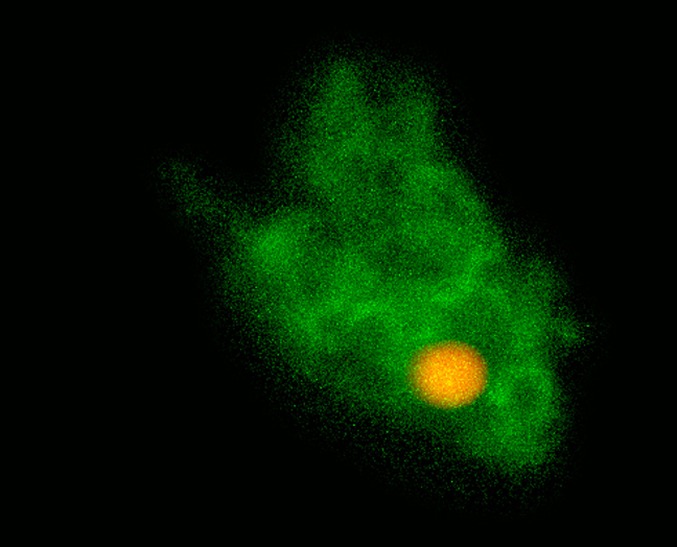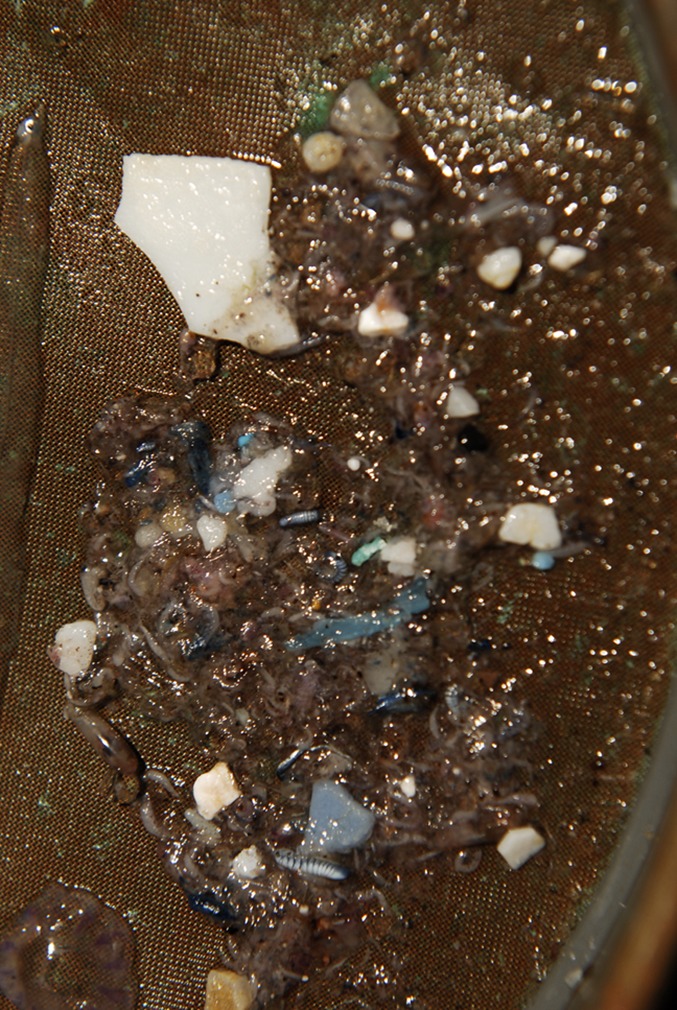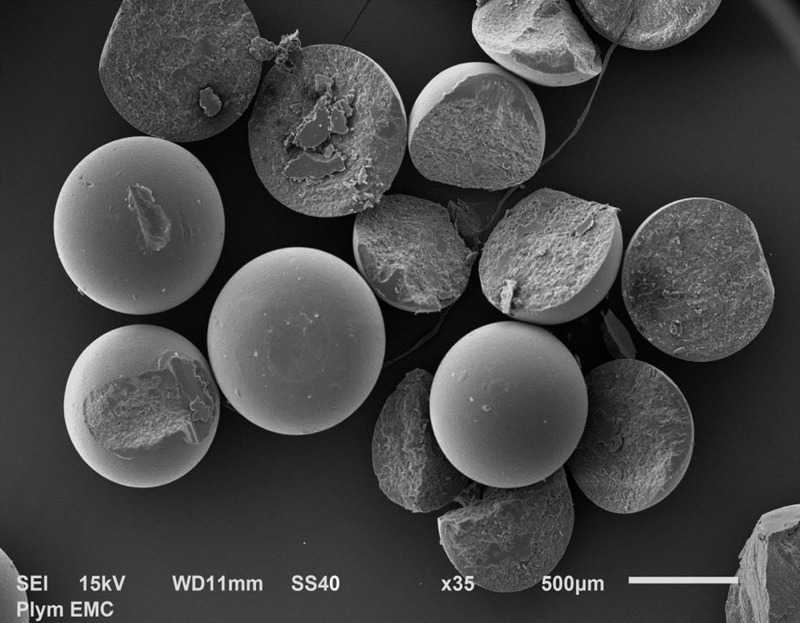Tiny particles of plastic are awash in the oceans—but how are they affecting marine life?
When Mark Browne set out to study the plastic waste that litters the oceans, he hadn’t planned on doing laundry in the name of science. Browne, an ecologist at the University of New South Wales, Australia, was aiming to chart the quantities and types of plastic fragments washing up on shores worldwide. Five years ago, he and his colleagues had already found a surprisingly large amount of nylon and polyester fibers, particularly near heavily populated areas. When they sampled sewage effluent, as well as decades-old sewage dumps, Browne and his colleagues found the same range of fibers, in exactly the same proportions of polymers used by the clothing industry.
Polyethylene beads such as these, extracted from a cosmetic product and shown in an electron micrograph, tend to pass through sewage treatment plants and end up in natural waters. Image courtesy of Adil Bakir and Richard Thompson (Plymouth University, United Kingdom).

Microplastic particles (yellow) can cross from the digestive system into the blood cells (green) of mussels. Image courtesy of Mark Browne (University of New South Wales, Australia).

A surface trawl in the middle of the South Atlantic Gyre picks up plankton, shells, and bits of plastic. Image courtesy of Stiv Wilson (The Story of Stuff Project).
So Browne set up three washing machines and began running synthetic blankets, shirts, and sweaters through the spin cycle, testing the water that drained out of the machines. “Our water footprint was probably huge,” he says, “but the amounts [of fibers] we detected were alarming.” Garments such as fleeces shed up to 1,900 tiny fibers every time they were washed (1). Too small to be filtered out of the sewage system, the fibers would eventually find their way to open water, Browne says.
Such fibers are the most abundant type of microplastic: pieces of plastic less than 5 millimeters in size that are becoming increasingly common in the ocean. Over the past decade, Browne and a growing number of other researchers have begun investigating precisely where microplastic is found and how it affects marine life. Various groups have found the stuff inside the digestive tracts of more than 100 different species (2), from zooplankton to whales, and discovered that it can pass through the gills of crabs and fish. Worryingly, microplastic also soaks up pollutants that are present in the ocean and delivers them into sea creatures’ tissues.
However, researchers still know remarkably little about how toxic this plastic may be for humans and other animals, or the disruption it causes to ecosystems. “In terms of demonstrating harm, the jury’s still out, in my opinion,” says Richard Thompson, a marine biologist at the University of Plymouth, United Kingdom. “I think that’s the cutting edge of the science at the moment.”
Sounding the Alarm
About 300 million tons of plastic is manufactured every year, and between 5 and 13 million tons of it of it ends up in the ocean. Where it lingers is still an open question (3). One study, based on samples taken on 24 expeditions over six years, estimated that some 269,000 tons of the plastic remains afloat on the ocean’s surface (4). Much of that is in “macro” form: large hunks of trash, such as fishing nets, buoys, and packaging that litters shorelines or swirls around the enormous circular current systems of the Pacific, Atlantic, and Indian Oceans. Quantifying seaborne microplastic—synthetic fibers, microbeads that are used in cosmetics and industrial cleansers, and scraps broken off of every other type of plastic in the water—is even more complicated. The most recent estimate of 35,500 tons (4) is on a par with previous studies (5, 6), but the number is much lower than expected. The missing microplastic waste has perhaps sunk into the depths of the ocean, washed ashore onto beaches, or been swallowed into the guts of marine animals.
Thompson’s laboratory recently showed that vast quantities of microplastic fibers are present on the deep sea floor, about four times the amount seen at the surface (7). “Even if we could wave a magic wand and stop all inputs of debris to the ocean, the numbers of microplastic pieces are only going to increase in the next few decades because of the legacy contaminants that are already there,” Thompson says. Given that plastic manufacturing is predicted to rise steadily to 33 billion tons by 2050, that increase is likely to be sharp.
Thompson was one of the first scientists to sound the alarm over microplastic. Researchers first reported finding small pieces of plastic in fish more than 40 years ago (8), but it wasn’t until 2004 that Thompson showed the presence of truly microscopic pieces, which he called microplastic. As a graduate student, Thompson had noticed the small fragments that everyone else stomped over at volunteer beach clean-ups. When he set up his own research group Thompson sent his students to collect the tiniest pieces of plastic they could find. He used a forensic technique called Fourier transform infrared spectroscopy to confirm that the microscopic grains from sand and seawater were indeed plastic, and compared water from the Atlantic Ocean with samples taken decades earlier to prove that microplastic had become much more abundant over the years (9).
By that time, Hideshige Takada, a geochemist at Tokyo University of Agriculture and Technology in Japan, was already analyzing the chemical composition of plastic resin pellets that a colleague had noticed on beaches in Tokyo Bay. These 3-millimeter-wide granules are the raw materials for commercial plastic products, and they are ubiquitous on shores worldwide. Takada’s laboratory discovered that they contained organic pollutants such as dioxins, polychlorinated biphenyls (PCBs), and dichlorodiphenyltrichloroethane, at one million times their concentrations in sea water (10). These hydrophobic contaminants have a high affinity for the water-free environment found between the long carbon chains that make up plastics, so the pellets mop up the chemicals as they sail across the ocean.
More recently, Chelsea Rochman, a postdoctoral fellow in the aquatic health program at the University of California, Davis, measured the amounts of PCBs and polycyclic aromatic hydrocarbons (also persistent pollutants) that were absorbed or adsorbed by the five most common types of mass-produced plastic. Rochman deployed plastic samples at five locations in the San Diego Bay for up to 12 months, and found that polyethylene and polypropylene—the most widely produced and consumed plastics—could accumulate roughly 10 times more of the pollutants than other types of microplastic (11).
These sponge-like properties make the widespread distribution of microplastic especially concerning, researchers say. The particles have been found in pretty much every ocean habitat from the tropics to the Arctic, and there is strong evidence for their long-term bioaccumulation in organisms. Takada and his colleagues studied sea birds called short-tailed shearwaters (Puffinus tenuirostris) that had ingested microplastic loaded with flame-retardant chemicals called polybrominated diphenyl ethers (PDBEs), and detected the pollutant in the birds’ adipose tissue (12). Rochman has found that pelagic fish—those that live between the shore and the sea floor—are more contaminated with PBDEs if they live in areas of greater plastic density (13). This finding suggests that the plastic noticeably contributed to the animals’ PBDE levels.
It’s not just the chemicals hidden inside microplastic that can bioaccumulate. In some cases, the particles themselves find their way from the gut into internal cells and tissues. Browne and his colleagues published the first study to show this. He collected mussels (Mytilus edulis) from the seaside in Cornwall, United Kingdom, and placed them into tanks containing fluorescently labeled polystyrene microspheres. The particles quickly accumulated in the bivalves’ guts and then migrated to the circulatory system, where they persisted for more than 48 days (14). “This was a game-changer, because up until that point everyone thought that these particles would be ingested and then go right out the other side,” says Browne.
This bioaccumulation has also been seen in wild bivalves. Last year, Belgian researchers studying seafood from German farms and French supermarkets found that an average portion of mussels contained about 90 microplastic particles, and an order of oysters would contain about 50 particles (15). However, Reinhardt Saborowski, an ecologist at the Helmholtz Center for Polar and Marine Research in Bremerhaven, Germany, points out that this does not necessarily mean that the creatures are harmed by their plastic passengers. Organisms are likely to respond to microplastic in different ways, he says, depending on their size, whether they feed selectively or not, and how easily substances pass from the digestive tract to other parts of the body. For example, Saborowski’s team found that a tiny marine isopod called Idotea emarginata has a gut anatomy that prevents particles from accumulating, which limits some of the adverse effects that microplastic ingestion could have, including clogged digestive organs and reduced appetite (16).
Indeed, only a handful of studies have found evidence of physiological, chemical, or other negative responses to microplastic ingestion. In one, Browne’s group focused on lugworms (Arenicola marina), which live in sediments on the shores of the United States and Europe and are eaten by many birds and fish. Browne reared the lugworms in sand containing 5% microplastic (from polyvinyl chloride), a rough estimation of natural levels (although determining natural levels with any consistency has been difficult, Browne notes). That contamination alone reduced the worms’ capacity to deal with oxidative stress (which commonly occurs for these organisms when the tide is out on a warm day) and led to an increase of hydrogen peroxide in their tissues. Some of the microplastic was contaminated with two chemical pollutants—nonylphenol and phenanthrene—that are commonly found in ocean water, as well as additives such as the antimicrobial agent triclosan. The organisms didn’t fare well: nonylphenol reduced their ability to fend off pathogenic bacteria by 60%. Triclosan raised their mortality by more than 55%; it also reduced their ability to feed and engineer sediments, which helps maintain the diversity of tidal flats (17).
In a complementary study from Thompson’s laboratory, lugworms raised in sediment containing 5% polyvinyl chloride ate less, showed increased inflammation, and also suffered a 50% drop in energy reserves, as measured by levels of carbohydrates, proteins, and fats in their bodies (18). And ongoing work from Rochman’s laboratory found that when a fish called the Japanese medaka (Oryzias latipes) was fed environmentally relevant levels of polyethylene marine debris, it experienced liver stress and signs of endocrine disruption (19).
Browne’s mussel study also found that smaller microplastic particles transferred from the gut and bioaccumulated in other tissues more quickly than larger particles. He and others believe that nano-scale particles could cause even more harm, but the idea is difficult to test because researchers do not yet have the tools to routinely sample microplastic smaller than 50 micrometers across, says Kara Lavender Law, research professor of oceanography at the Sea Education Association in Woods Hole, Massachusetts.
A Pressing Issue?
These studies come with a major caveat: almost all of them were done in the laboratory and it is not clear how well they reflect processes occurring in the wild. Persistent organic pollutants and other chemicals are already present in the marine environment, and it is hard to say how much additional harm a gulp of microplastics might cause. Plastic is very visible, says Christopher Reddy, a chemical oceanographer at the Woods Hole Oceanographic Institution in Woods Hole, Massachusetts, so it gets a lot of attention. But other environmental issues—carbon dioxide emissions, for example, or coastal erosion—are significantly more problematic. “These are big, pressing issues that are going to change economies and change societies,” Reddy says.
And at a chemical level, an organism’s intake of toxic substances from microplastic may be dwarfed by the inputs from its food and water, according to modeling studies by Bart Koelmans, an aquatic ecologist and chemist at Wageningen University in The Netherlands (20, 21). Koelmans’s model predicts the fate of different pollutants ingested in food, water, and plastic particles, based
“This is only the start of thinking about the problem in a rigorous way,” says Kara Lavender Law.
on factors such as the pollutants’ solubility and the organisms’ digestion. Small animals like marine worms are especially unlikely to absorb significant amounts of chemicals because they probably retain microplastic in their guts for relatively short periods of time, the model suggests. And if the animal already has high levels of contaminants in its system, the chemicals, in principle, could even be absorbed in the opposite direction—from the body to the microplastic—which might produce a cleansing effect, says Koelmans.
Modeling studies such as these have their own limitations, though. It is not clear that modeling is any more accurate than laboratory experiments in determining how the concentrated presence of these chemicals in microplastic affects organisms in nature, says Rochman. And Koelmans’s model does not reflect the impact of stress or inflammation caused by microplastic ingestion. “This is a chemical model, but of course there is also biology,” he says.
Ultimately, researchers agree that there are still too many unknowns to fully assess the environmental damage caused by microplastic. However, a host of new studies, many of which are moving from the laboratory to the field, should fill in these gaps. Rochman is expanding her work on how chemical transfer varies by plastic type and how bioaccumulation moves up the food chain. A group led by Robert Hale at the Virginia Institute of Marine Science in Gloucester Point is gearing up to take a closer look at leaching from different types of plastic under a wide range of conditions.
Meanwhile, Takada hopes to expand his group’s work on short-tailed shearwaters to other animals, such as turtles and seals. Linda Amaral Zettler at the Marine Biological Laboratory is studying how plastics break down in the ocean, and hopes to discover what role microbes play in the process. And Browne’s team recently embarked on a study that will look beyond physiology and assess the impacts of microplastic pollution in the food web.
Despite the warning signs that researchers have already found, it may be many years before the microplastic pollution puzzle is solved. “This is only the start of thinking about the problem in a rigorous way,” says Law.
References
- 1.Browne MA, et al. Accumulation of microplastic on shorelines woldwide: Sources and sinks. Environ Sci Technol. 2011;45(21):9175–9179. doi: 10.1021/es201811s. [DOI] [PubMed] [Google Scholar]
- 2. Secretariat of the Convention on Biological Diversity and the Scientific and Technical Advisory Panel—GEF (2012). Impacts of Marine Debris on Biodiversity: Current Status and Potential Solutions (Secretariat of the Convention on Biological Diversity, Montreal), Technical Series No. 67.
- 3.Jambeck JR, et al. Marine pollution. Plastic waste inputs from land into the ocean. Science. 2015;347(6223):768–771. doi: 10.1126/science.1260352. [DOI] [PubMed] [Google Scholar]
- 4.Eriksen M, et al. Plastic pollution in the world’s oceans: More than 5 trillion plastic pieces weighing over 250,000 tons afloat at sea. PLoS ONE. 2014;9(12):e111913. doi: 10.1371/journal.pone.0111913. [DOI] [PMC free article] [PubMed] [Google Scholar]
- 5.Law KL, et al. Distribution of surface plastic debris in the eastern Pacific Ocean from an 11-year data set. Environ Sci Technol. 2014;48(9):4732–4738. doi: 10.1021/es4053076. [DOI] [PubMed] [Google Scholar]
- 6.Cózar A, et al. Plastic debris in the open ocean. Proc Natl Acad Sci USA. 2014;111(28):10239–10244. doi: 10.1073/pnas.1314705111. [DOI] [PMC free article] [PubMed] [Google Scholar]
- 7.Woodall LC, et al. The deep sea is a major sink for microplastic debris. R Soc Open Sci. 2014;1:140317. doi: 10.1098/rsos.140317. [DOI] [PMC free article] [PubMed] [Google Scholar]
- 8.Carpenter EJ, Smith KL., Jr Plastics on the Sargasso sea surface. Science. 1972;175(4027):1240–1241. doi: 10.1126/science.175.4027.1240. [DOI] [PubMed] [Google Scholar]
- 9.Thompson RC, et al. Lost at sea: Where is all the plastic? Science. 2004;304(5672):838. doi: 10.1126/science.1094559. [DOI] [PubMed] [Google Scholar]
- 10.Takada S. International Pellet Watch studies of the magnitude and spatial variation of chemical risks associated with environmental plastics. In: Gabrys J, et al., editors. From Accumulation: The Material Politics of Plastic. Routledge; New York: 2013. [Google Scholar]
- 11.Rochman CM, Hoh E, Hentschel BT, Kaye S. Long-term field measurement of sorption of organic contaminants to five types of plastic pellets: Implications for plastic marine debris. Environ Sci Technol. 2013;47(3):1646–1654. doi: 10.1021/es303700s. [DOI] [PubMed] [Google Scholar]
- 12.Tanaka K, et al. Accumulation of plastic-derived chemicals in tissues of seabirds ingesting marine plastics. Mar Pollut Bull. 2013;69(1-2):219–222. doi: 10.1016/j.marpolbul.2012.12.010. [DOI] [PubMed] [Google Scholar]
- 13.Rochman CM, et al. Polybrominated diphenyl ethers (PBDEs) in fish tissue may be an indicator of plastic contamination in marine habitats. Sci Total Environ. 2014;476-477:622–633. doi: 10.1016/j.scitotenv.2014.01.058. [DOI] [PubMed] [Google Scholar]
- 14.Browne MA, Dissanayake A, Galloway TS, Lowe DM, Thompson RC. Ingested microscopic plastic translocates to the circulatory system of the mussel, Mytilus edulis (L) Environ Sci Technol. 2008;42(13):5026–5031. doi: 10.1021/es800249a. [DOI] [PubMed] [Google Scholar]
- 15.Van Cauwenberghe L, Janssen CR. Microplastics in bivalves cultured for human consumption. Environ Pollut. 2014;193:65–70. doi: 10.1016/j.envpol.2014.06.010. [DOI] [PubMed] [Google Scholar]
- 16.Hämer J, Gutow L, Köhler A, Saborowski R. Fate of microplastics in the marine isopod Idotea emarginata. Environ Sci Technol. 2014;48(22):13451–13458. doi: 10.1021/es501385y. [DOI] [PubMed] [Google Scholar]
- 17.Browne MA, Niven SJ, Galloway TS, Rowland SJ, Thompson RC. Microplastic moves pollutants and additives to worms, reducing functions linked to health and biodiversity. Curr Biol. 2013;23(23):2388–2392. doi: 10.1016/j.cub.2013.10.012. [DOI] [PubMed] [Google Scholar]
- 18.Wright SL, Rowe D, Thompson RC, Galloway TS. Microplastic ingestion decreases energy reserves in marine worms. Curr Biol. 2013;23(23):R1031–R1033. doi: 10.1016/j.cub.2013.10.068. [DOI] [PubMed] [Google Scholar]
- 19.Rochman CM, Kurobe T, Flores I, Teh SJ. Early warning signs of endocrine disruption in adult fish from the ingestion of polyethylene with and without sorbed chemical pollutants from the marine environment. Sci Total Environ. 2014;493:656–661. doi: 10.1016/j.scitotenv.2014.06.051. [DOI] [PubMed] [Google Scholar]
- 20.Koelmans AA, Besseling E, Wegner A, Foekema EM. Plastic as a carrier of POPs to aquatic organisms: A model analysis. Environ Sci Technol. 2013;47(14):7812–7820. doi: 10.1021/es401169n. [DOI] [PubMed] [Google Scholar]
- 21.Gouin T, Roche N, Lohmann R, Hodges G. A thermodynamic approach for assessing the environmental exposure of chemicals absorbed to microplastic. Environ Sci Technol. 2011;45(4):1466–1472. doi: 10.1021/es1032025. [DOI] [PubMed] [Google Scholar]



